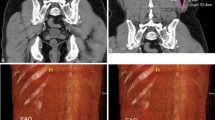Abstract
Introduction
Hernias through the triangle of Petit (TP) are uncommon. The anatomy of the TP is known to be variable, yet quantitative data are scant.
Materials and methods
The triangle was observed in 80 adult cadavers and its dimensions and surface area were measured.
Results
On the basis of surface area we classified the triangles into four types. Type I or small TP, with a surface area of <8 cm2, accounted for 43.7% of our specimens. Type II (26.2%) were intermediate in size, with a surface areas of 8–12 cm2. Type III (12.5%) were large triangles with surface areas >12 cm2. Finally, Type IV (17.5%) were not triangles. In these, the latissimus dorsi was covered by the external abdominal oblique muscle.
Conclusions
We hope these data will help prediction of which patients are at greater risk of herniation through the TP.




Similar content being viewed by others
References
Clemente C (1984) In: Gray’s anatomy, fasciae and muscles of the trunk, 30th edn. Williams and Wilkins, Baltimore, pp 465–466
Hollinshead HW (1982) Anatomy for surgeons, vol 3, 3rd edn. Harper and Row, Philadelphia, pp 151–152
Rutkow IM (2003) A selective history of hernia surgery in the late eighteenth century: the treatises of Percival Pott, Jean Louis Petit, D August Gottlieb Richter, Don Antonio de Gimbernat, and Pieter Camper. Surg Clin N Am 83:1021–1044
Standring S (2005) Grays anatomy, 39th edn, Chap. 45. The back. Elsevier/Churchill/Livingstone, Edinburgh, pp 734–735
Light HG (1983) Hernia of the inferior lumbar space: a cause of back pain. Arch Surg 118:1077–1080
Astarcıoğlu H, Sökmen S, Atila K, Karademir S (2003) Incarcerated inferior lumbar (Petit’s) hernia. Hernia 7:158–160
Davis GG (1926) Davis’ applied anatomy abdomen, 6th edn. Lippincott, Philadelphia, pp 398–399
Skandalakis JE, Colborn GL, Weidman TA, Foster RS, Kingsnorth AN, Skandalakis LJ, Skandalakis PN, Mirilas PS (2004) Surgical anatomy. Abdominal wall and hernias. Paschalidis Medical Publishers, Athens, p 149
Burt BM, Afifi HY, Wantz GE, Barie PS (2004) Traumatic lumbar hernia: report of cases and comprehensive review of the literature. J Trauma 57:1361–1370
Millard DG (1959) A Richter’s hernia through the inferior lumbar triangle of Petit: a radiographic demonstration. Br J Radiol 32:693–695
Loukas M, Louis RG Jr, Hullett J, Loiacano M, Skidd P, Wagner T (2005) An anatomical classification of the variations of the inferior phrenic vein. Surg Radiol Anat 27:566–574
Barbette P (1672) Opera chirurgico-anatomica. Lugduni, Gelder
deGarangeor RJC (1731) Traite des operations de chirurgie
Orcutt TW (1971) Hernia of the superior lumbar triangle. Ann Surg 173:294–297
Guillem P, Czarnecki E, Duval G, Bounoua F, Fontaine C (2002) Lumbar hernia: anatomical route assessed by computed tomography. Surg Radiol Anat 24:53–56
Ng SSM, Ng NC, Liu AYW, Lee FY (2006) Radiology for the surgeon: soft-tissue case 58. Can J Surg 49:129–130
Esposito TJ, Fedorak I (1994) Traumatic lumbar hernia: case report and literature review. J Trauma 37:123–126
Geis WP, Saletta JD (1989) Lumbar hernia. In: Nyhus LM, Condon RE (eds) Hernia. Lippincott, Philadelphia, pp 401–415
Somuncu S, Berbay F, Rizalar R, Ariturk E, Gunaydin M, Gurses N (1997) Congenital lumbar hernia associated with the lumbocostovertebral syndrome: two cases. Eur J Pediatr Surg 7:122–124
Patten LC, Awad SS, Berger DH, Fagan SP (2004) A novel technique for the repair of lumbar hernias after iliac crest bone harvest. Am J Surg 188:85–89
Balkan M, Kozak O, Gulec B, Tasar M, Pekcan M (1999) Traumatic lumbar hernia due to seat belt injury: case report. J Trauma 47:154–155
Challis JH, Lyttle JA, Stuart AE (1975) Strangulated lumbar hernia and volvulus following removal of iliac crest bone graft. Acta Orthop Scand 46:230–233
Pyrtek LJ, Kelly CC (1960) Management of herniation through large iliac bone defects. Ann Surg 152:998–1003
James EC, Corry RJ, Perry JF Jr (1987) Principles of basic surgical practice. Hanley and Belfus Medical Publishers, Philadelphia, pp 352–353
Townsend CM Jr, Beauchamp RD, Evers BM, Mattox KL (2004) Sabiston textbook of surgery: the biological basis of modern surgical practice, 17th edn, chap 42, Hernias. Elsevier/Saunders, Philadelphia, pp 1214–1215
Moreno-Egea A, Torralba JA, Morales G, Fernandez T, Guzman P, Hita G, Girela E, Corral M, Campillo A, Aguayo JL (2005) Open vs laparoscopic repair of secondary lumbar hernias: a prospective nonrandomized study. Surg Endosc 19:184–187
Zhou X, Nve JO, Chen G (2004) Lumbar hernia: clinical analysis of 11 cases. Hernia 8:260–263
Author information
Authors and Affiliations
Corresponding author
Rights and permissions
About this article
Cite this article
Loukas, M., Tubbs, R.S., El-Sedfy, A. et al. The clinical anatomy of the triangle of Petit. Hernia 11, 441–444 (2007). https://doi.org/10.1007/s10029-007-0232-5
Received:
Accepted:
Published:
Issue Date:
DOI: https://doi.org/10.1007/s10029-007-0232-5




